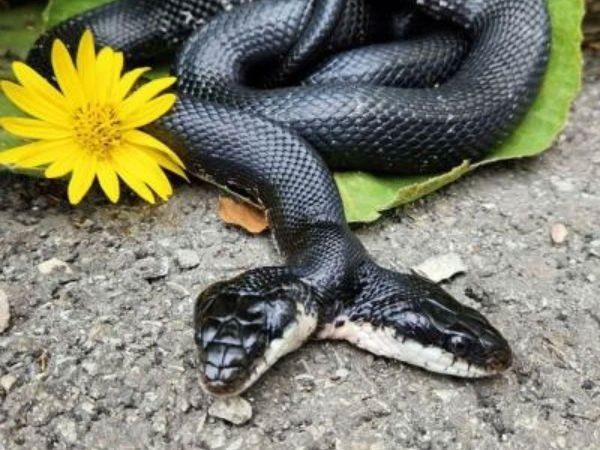A Rare Two-Headed Snake at Missouri Conservation Area Undergoes Surgery After Vomiting Blood While Eating.
Missouri Conservation Area (MDC) reports that this unusual reptile is a two-headed rat snake named Tiger-Lily, currently receiving care at the Powder Valley Nature Center. It was observed vomiting “blood spots” while being fed earlier this month, according to News Week.
The snake was then taken to veterinarians at the Saint Louis Zoo’s Veterinary Team. There, they discovered that Tiger-Lily was suffering from a condition known as temporary ovarian inactivity prior to ovulation, a common ailment in reptiles.

Two-headed rat snake undergoing surgery for ovarian stasis. (Photo: Missouri Conservation Area (MDC)).
Normally, the ovaries begin to form follicles, which develop into eggs and are released. However, sometimes this process encounters issues, causing the follicles to remain attached to the ovaries. This condition can lead to infections, inflammation, or even follicular rupture, weakening the reptile.
In the case of Tiger-Lily, although the reproductive cycle had begun, the follicles did not release but continued to grow and accumulate in the ovaries.
Veterinarian Michael Warshaw at the Saint Louis Zoo stated: “Over time, this leads to inflammation and a high risk of infection.”
On March 11, Tiger-Lily’s abnormal ovaries were successfully surgically removed at the Endangered Species Research Center and Veterinary Hospital of the Saint Louis Zoo. The surgery was successful, and the snake is recovering well.
“We appreciate the swift response and professional treatment from the Saint Louis Zoo,” shared Lauren Baker, a naturalist with the Missouri Conservation Area (MDC), in a statement.
According to information from the Saint Louis Zoo, Tiger-Lily was found in Stone County in 2017 and is extremely rare due to its two-headed condition. This condition, known as bicephaly, occurs due to various developmental issues during embryonic development.
In Tiger-Lily’s case, it is essentially a pair of conjoined twins that have not fully separated. This phenomenon has been recorded in the animal kingdom, from cattle, sharks to turtles and kittens, and even in extremely rare cases in humans.
However, this phenomenon is more commonly observed in reptiles than in mammals since the embryonic implantation process in mammals is often routinely monitored for abnormalities. Animals and humans with this condition rarely live long, making snakes like Tiger-Lily seldom found in the wild.


















































